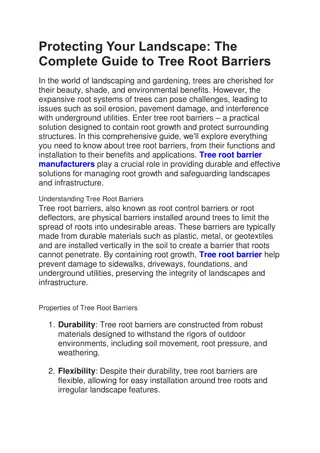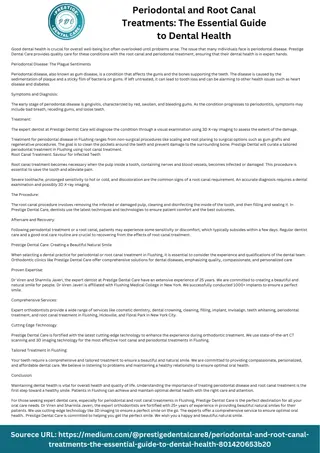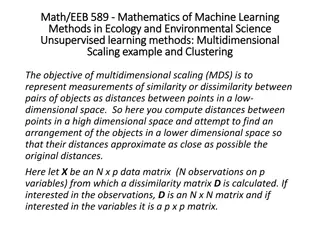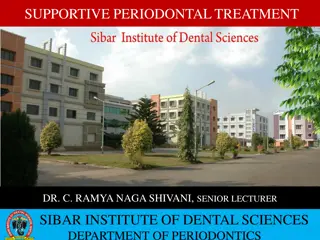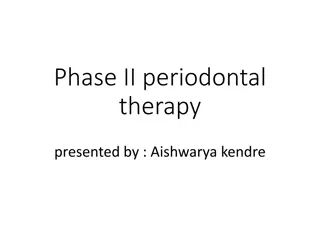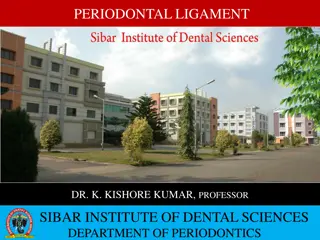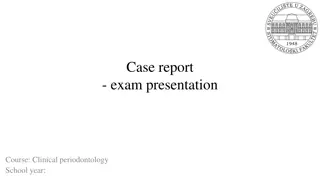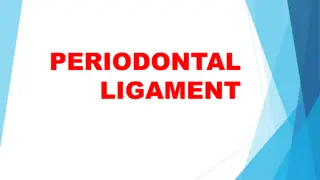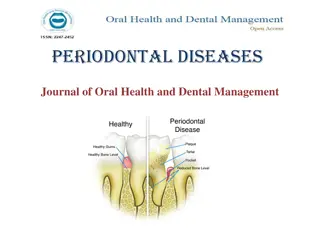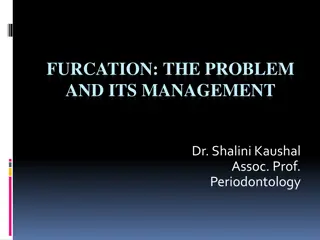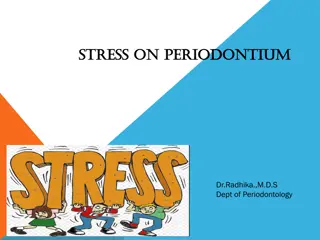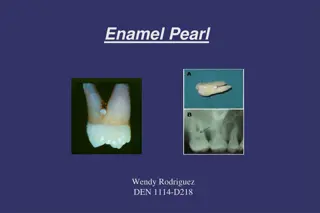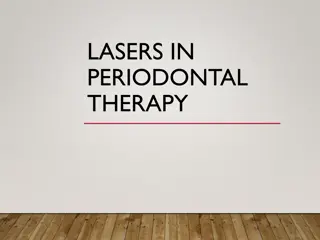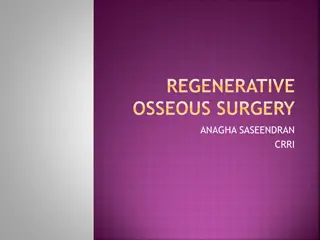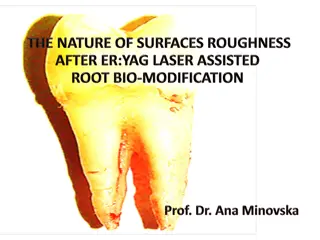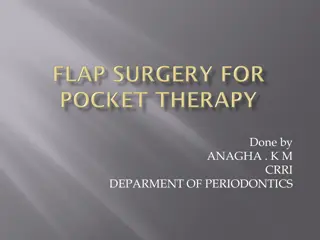Understanding Scaling and Root Planing in Periodontal Treatment
This comprehensive guide covers the definitions, advantages, categories, instruments used, procedures, techniques, and outcomes of scaling and root planing in dental care, highlighting the importance of this gold standard treatment for chronic periodontitis.
Download Presentation

Please find below an Image/Link to download the presentation.
The content on the website is provided AS IS for your information and personal use only. It may not be sold, licensed, or shared on other websites without obtaining consent from the author. Download presentation by click this link. If you encounter any issues during the download, it is possible that the publisher has removed the file from their server.
E N D
Presentation Transcript
Scaling and Root planing Presented by : Dr. Trupti Giri
Contents Introduction Defination Advantages of scaling and Root-Planing Categories Instruments used . Procedure Supragingival scaling techniques Subgingival scaling and root planning -Various approaches of instrumentation -Adverse effects -Outcome -Limitations -Conclusion
Defination SCALING:Instrumentation of the crown and root surfaces of the teeth to remove plaque, calculus, and stains from these surfaces. (Glossary of Periodontal Terms, 2001). ORAL PROPHYLAXIS: The removal of plaque, calculus, and stains from the exposed and unexposed surfaces of the teeth by scaling and polishing as a preventive measure for the control of local irritational factors. (Glossary of Periodontal Terms, 2001) ROOT PLANING: A treatment procedure designed to remove cementum or surface dentin that is rough, to a les impregnated with calculus, or contaminated with toxins or PERIO microorganisms. (Glossary of Periodontal Terms, 2001)
Advantages of scaling and root planing. Scaling and root planing (SRP) is the gold standard treatment for most patients with chronic periodontitis. It has a clear effect in reducing plaque-induced inflammation. F SRP also reduce the bacterial load. The removal of bacterial plaque and their products also reduce or eliminate the oral malodour.
CATEGORIES OF SCALING AND ROOT PLANING
Procedure A sharp instrument is to be used for hand scaling. Scaling should be carried out in an apical to coronal direction. A finger rest should be at the closest possible to the tooth being scaled. The cutting edge of the tip of the instrument should be maintained at an angulation of approximately 45 -90 angle to the tooth surface.
Supragingival Scaling Technique Supragingival calculus is generally less tenacious and less calcified than subgingival calculus. Sickles, curettes, and ultrasonic and sonic instruments are most often used for the removal of supragingival calculus. The sickle or curette is held with a modified pen grasp, and a firm finger rest is established on the teeth adjacent to the working area. The blade is adapted with an angulation of slightly less than 90 degrees to the surface being scaled. The cutting edge should engage the apical margin of the supragingival calculus while short, powerful, overlapping scaling strokes are activated coronally in a vertical or an oblique direction.
Subgingival Scaling and Root-Planing Technique Subgingival calculus is usually harder than supragingival calculus and is often locked into root irregularities, making it more tenacious and therefore more difficult to remove. Vision is obscured by the bleeding that inevitably occurs during instrumentation and by the tissue itself. In addition, the adjacent pocket wall limits the direction and length of the strokes. The curette is preferred by most clinicians for subgingival scaling and root planing because of the advantages afforded by its design.
As calculus is removed, resistance to the passage of the cutting edge diminishes until only a slight roughness remains. Longer, lighter root-planing strokes are then activated with less lateral pressure until the root surface is completely smooth and hard. Scaling and root-planing strokes should be confined to the portion of the tooth where calculus or altered cementum is found; this area is known as the instrumentation zone. Sweeping the instrument over the crown where it is not needed wastes operating time, dulls the instrument, and causes loss of control.
If heavy lateral pressure is continued after the bulk of calculus has been removed and the blade is repeatedly readapted with short, choppy strokes, the result will be a roughened root surface, resembling the rippled surface of a washboard. If heavy lateral pressure is continued with long, even strokes, the result will be excessive removal of root structure, producing a smooth but ditched or riffled root surface. To avoid these hazards of over instrumentation, a deliberate transition from short, powerful scaling strokes to longer, lighter root-planing strokes must be made as soon as the calculus and initial roughness have been eliminated.
Various approaches to instrumentation: Maxillary right posterior sextant:facial aspect - Operator position: Side position. - Illumination: Direct. - Visibility: Direct (indirect for distal surfaces of molars). - Retraction: Mirror or index finger of the nonoperating hand. Finger rest: Extraoral, palm up.
Maxillary right posterior sextant, premolar region only: Facial aspect. - ---- Operator position: Side or back position. - Illumination: Direct. - Visibility: Direct. - Retraction: Mirror or index finger of the nonoperating hand. - Finger rest: Intraoral, palm up. Fourth finger on the occlusal surfaces of the adjacent maxillary posterior teeth.
Maxillary right posterior sextant: Lingual aspect Operator position: Front position. Illumination: Direct. Visibility: Direct. - Retraction: None. - Finger rest: Intraoral, palm up, finger on finger.
Maxillary anterior sextant: Facial aspect, surfaces away from the operator Operator position: Back position. - Illumination: direct Visibility: Direct. Retraction: Index finger of the nonoperating hand. - Finger rest: Intraoral, palm up. Fourth finger on the incisal edges or occlusal surfaces of adjacent maxillary teeth.
Maxillary right posterior sextant: Lingual aspect Operator position: Front position. Illumination: Direct. Visibility: Direct. Retraction: None. Finger rest: Intraoral, palm up, finger on finger.
Maxillary anterior sextant: Facial aspect, surfaces toward the operator Operator position: Front position. Illumination: Direct. Visibility: Direct. Retraction: Index finger of the nonoperating hand. Finger rest: Intraoral, palm down. Fourth finger on the incisal edges or the occlusal or facial surfaces of adjacent maxillary teeth.
Maxillary anterior sextant: Lingual aspect, surfaces away from the operator Operator position: Back position. Illumination: Indirect. Visibility: Indirect. Retraction: None. Finger rest: Intraoral, palm up. Fourth finger on the incisal edges or the occlusal surfaces of adjacent maxillary teeth
Maxillary left posterior sextant: Facial aspect. Operator position: Side or back position. Illumination: Direct or indirect. Visibility: Direct or indirect. Retraction: Mirror. Fingear rest: Extraoral, palm down. Front surfaces of the middle and fourth fingers on the lateral aspect of the mandible on the left side of the face.
Maxillary left posterior sextant: Facial aspect Operator position: Back or side position. - Illumination: Direct or indirect. Visibility: Direct or indirect. Retraction: Mirror. Finger rest: Intraoral, palm up. Fourth finger on the incisal edges or the occlusal surfaces of adjacent maxillary teeth
Maxillary left posterior sextant: Lingual aspect Operator position: Front position. - Illumination: Direct. - Visibility: Direct. Retraction: None. Finger rest: Intraoral, palm down, opposite arch, reinforced. Fourth finger on the incisal edges of the mandibular anterior teeth or the facial surfaces of the mandibular premolars, reinforced with the index finger of the nonoperating hand.
Maxillary left posterior sextant: Lingual aspect Operator position: Front position. Illumination: Direct and indirect. Visibility: Direct and indirect. Retraction: None. Finger rest: Extraoral, palm down. Front surfaces of the middle and fourth fingers on the lateral aspect of the mandible on the left side of the face. The nonoperating hand holds the mirror for indirect illumination.
Maxillary left posterior sextant: Lingual aspect Operator position: Side or front position. - Illumination: Direct. Visibility: Direct. Retraction: None. Finger rest: Intraoral, palm up. Fourth finger on the occlusal surfaces of adjacent maxillary teeth.
Mandibular left posterior sextant: Facial aspect Operator position: Side or back position. Illumination: Direct. Visibility: Direct or indirect. Retraction: Index finger or mirror of the non-operating hand. Finger rest: Intraoral, palm down. Fourth finger on the incisal edges or the occlusal or facial surfaces of adjacent mandibular teeth.
Mandibular left posterior sextant: Lingual aspect Operator position: Front or side position. Illumination: Direct and indirect. Visibility: Direct. Retraction: Mirror retracts tongue. Finger rest: Intraoral, palm down. Fourth finger on the incisal edges or the occlusal surfaces of adjacent mandibular teeth.
Mandibular anterior sextant: Facial aspect, surfaces toward the operator Operator position: Front position. - Illumination: Direct. Visibility: Direct. Retraction: Index finger of the non-operating hand. - Finger rest: Intraoral, palm down. Fourth finger on the incisal edges or the occlusal surfaces of adjacent mandibular teeth.
Mandibular anterior sextant: Facial aspect, surfaces away from the operator. Operator position: Back position. Illumination: Direct. Visibility: Direct. Retraction: Index finger or thumb of the nonoperating hand. Finger rest: Intraoral, palm down. Fourth finger on the incisal edges or the occlusal surfaces of adjacent mandibular teeth.
Mandibular anterior sextant: Lingual aspect, surfaces away from the operator Operator position: Back position. Illumination: Direct and indirect. Visibility: Direct and indirect. Retraction: Mirror retracts tongue. Finger rest: Intraoral, palm down. Fourth finger on the incisal edges or the occlusal surfaces of adjacent mandibular teeth.
Mandibular anterior sextant: Lingual aspect, surfaces toward the operator. Operator position: Front position. Illumination: Direct and indirect. Visibility: Direct and indirect. Retraction: Mirror retracts tongue. Finger rest: Intraoral, palm down. Fourth finger on the incisal edges or the occlusal surfaces of adjacent mandibular teeth.
Mandibular right posterior sextant: Facial aspect. Operator position: Side or front position. Illumination: Direct. Visibility: Direct. Retraction: Mirror or index finger of the nonoperating hand. Finger rest: Intraoral, palm down. Fourth finger on the incisal edges or the occlusal surfaces of adjacent mandibular teeth.
Mandibular right posterior sextant: Lingual aspect. Operator position: Front position. Illumination: Direct and indirect. Visibility: Direct and indirect. Retraction: Mirror retracts tongue. Finger rest: Intraoral, palm down. Fourth finger on the incisal edges or the occlusal surfaces of adjacent mandibular teeth.
Adverse effects of Scaling and Root planing: Scaling and root planing is invasive in nature but is a non-surgical procedure Gingival recession: In shallow pockets of less than 3 mm it may cause loss of attachment especially with thin gingival biotypes. Damage to or loss of tooth substance: It is especially evident in case of the earlier concepts of root planing where the clinicians meticulously made the hourglass like root surface resulting in significant amounts of tooth loss. Root Sensitivity: Root sensitivity is distinct from dentinal hypersensitivity in that the former is a result of periodontal therapy or periodontitis, the latter of hydrodynamic stimulation. Current best evidence suggests that over half of all patients suffer from root sensitivity after periodontal treatment. The intensity of root sensitivity increases for a few weeks after therapy, after which it decreases.
Machine (Sonic and Ultrasonic) Vs Hand Instruments for Scaling and Root Planning Evidence fails to suggest any difference is their efficacy. Sonic and ultrasonic instrumentation may be faster.
Effects of Scaling and Root Planing: Scaling and root planing is able to improve significantly clinical attachment levels between 0.55 and 1.29 mm and to reduce probing pocket depths between 1.29 and 2.16 mm. It also leads to a reduction in bleeding on probing. These results are mostly dependent on the extent and severity of disease and the limitations of the non- surgical therapy. Scaling and Root Planning It has also been noticed that the results are not dependent on the mode of debridement, as both power driven and The following is the summary of the outcomes of scaling hand instrumentation demonstrated similar outcomes. A comprehensive meta-analysis of nonsurgical treatment studies reported that for patients with chronic periodontitis, following scaling and root planing at sites with probing
Limitations of scaling and root planning Inability to access deep and tortuous pockets, distal surfaces of molars, mesial surfaces of upper first premolars with root grooves, furcation involved sites in multirooted teeth, root irregularities or anomalies and hence their management. Inability to eliminate certain pathogens.
Conclusion Scaling and root planing is one of the most effective ways to treat gum disease before it becomes severe. Proper instrumentation technique and chair positions helps the operator to complete the procedure without delaying and also reduces the chances of future musculoskeletal problems.
You dont have to lose teeth to periodontal diseases. They often can be treated successfully.



